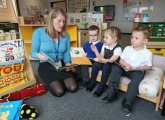Taking arts and crafts activities outside can invigorate young children’s creativity, says Barbara Isaacs…
Most early years settings are well-organised when it comes to providing opportunities for spontaneous activities in the arts and crafts area. Many have established ‘art trolleys or shelves’ which give children opportunities to select resources and create their own works of art, be they collages, drawings, paintings, prints or cuttings. Alongside these paper-based activities, there are often opportunities to use playdough, modelling clay and boxes and other materials such as short pieces of wood to produce three dimensional constructions too. Much of the success of these activities depends on the quality of resources and on the adults’ attitude – in particular, their willingness to give young children the time and opportunity to explore what can be done. The key is to introduce techniques such as printing or marbling and then make them readily available for the children to use when they are ready and when they have time to experiment and to find out what can be achieved.
Some settings also provide for creative expression in the outdoor classroom – often encouraging large constructions and giving opportunities for painting using large brushes. There is no doubt children benefit from these resources. However, have you ever considered providing the same freedom of access to activities by offering an ‘outdoor art shelf’, with different resources such as twigs, leaves and petals, pebbles and other nature-given resources, which can be found in the garden, during walks in the local park and at forest school activities. These can enhance children’s sensory learning and extend your collage and construction resources.
This kind of outdoor provision may also encourage social skills and promote opportunities for children to make individual contributions to cooperative efforts. Why not create a tree mobile that can be decorated with a variety of hangings made by different children such as birds made of twigs, CD reflectors, rainbows made from see-through coloured plastic sheets, and bows and plaits created from ribbons and strips of fabric.
Elsewhere, why not use a large sheet of chicken wire (be careful to protect the edges as they can be very sharp), securely attached to the nursery fence, as a base for group weaving. Provide a basket with strips of fabric and ribbons, wools and coloured pipe cleaners, silver foil and strips of plastic sheeting. You could exchange these resources for natural weaving materials such as blades of grass, leaves, twigs and petals. Encourage large constructions using large hollow blocks (if your setting is lucky enough to have them) or substitute these with cardboard packing cases or plastic crates. Use the sandpit to create a sculpture with pebbles, shells and twigs available for possible adornment. Provide clay for making pots and animals.
Use the ground to make pictures with coloured chalk or large sheets of paper for footprints, handprints or, if you’re feeling brave on a hot day, a body print. The outdoor classroom offers opportunities for large-scale work and for leaving activities unfinished to be continued the next day.
Talking to children about their art projects, inside or outside, can be an interesting contribution to their creative process; however, here we need to tread cautiously – asking direct questions may pressurise children into giving answers. Expressing appreciation of colours, shapes and forms is a good way to begin such conversations. Some of the Reggio Emilia documentation provides a good guide to gaining a deeper understanding of adults’ role in contributing to children’s creativity.
Finally, having an artist in residence is another excellent way to stimulate children’s creativity, while giving them new ideas about the different techniques they can use. Remember, at all times it is important to celebrate each individual’s or group’s efforts; photographing the various contributors at work and so recording the steps and progress of their artistry is one way of doing this. Sharing the photographs with children will give practitioners further insight into children’s thinking. And parents will benefit from these pictorial records too, by gaining a fresh insight into their children’s creativity.
Barbara Isaacs is the academic director of Montessori Centre International.

Keep SLC on top of the agenda
Editors picks
